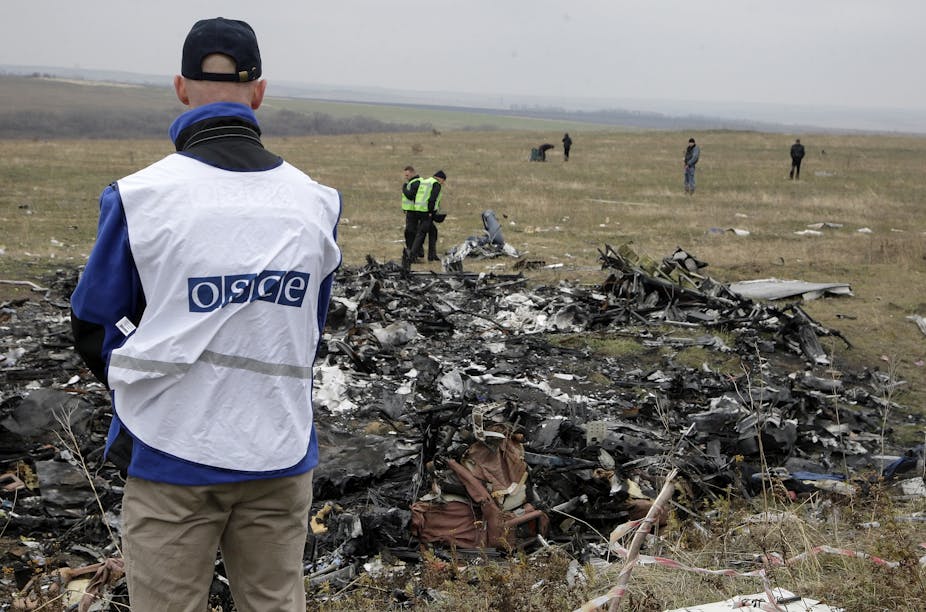A fragile peace agreement is in place in Ukraine – but the task of determining whether or not it is holding is proving to be a fraught one indeed.
As Kiev and the pro-Russian rebels fight a war of words over who is slowing down the enforcement of the Minsk II agreement, the Organisation for Security and Co-operation in Europe (OSCE) is doing its best to provide accurate picture of what’s really happening on the ground.
Once thought to have passed its use-by date, the OSCE has drawn new life from the conflict. It is once again seen as a vital agent of European peace and security – and as the only European security organisation that boasts both the Russia the US as participants, it’s been able to rise to the challenge for the very same reasons that many observers previously nearly wrote it off.
Détente
The OSCE was born as the Conference on Security and Co-operation in Europe (CSCE) in 1975 during of the détente era of the Cold War. It brought together NATO and Warsaw Pact countries along with non-aligned European states into one security governance group.
Nearly immediately written off by many sides as having sacrificed too much for too little, the CSCE was not based on any legal framework. Instead, it was a political agreement between participating states to ensure territorial integrity, human rights and common regional security challenges.
With the arrival of Mikhail Gorbachev as the leader of the Soviet Union, there began a series of motions that would lead to the OSCE that we know today. The “Conference on” was dropped in favour of “Organisation for” in 1994. Yet, many of the institutions that would go on to define the OSCE had already been established. These institutions include the Permanent Council, OSCE Parliamentary Assembly, High Commissioner on National Minorities, Conflict Prevention Centre, and Representative on the Freedom of the Media.
Since 1992, the OSCE has had field missions, offices and centres in place across Central and Eastern Europe and Central Asia, looking at everything from ethnic politics to communal policing. It was through these institutions that the organisation first got involved in Ukraine.
In 1994, an OSCE mission was dispatched to Ukraine to help address the situation in Crimea. Ukraine’s independence from the Soviet Union had dramatically increased ethnic tensions in the region, with a predominantly ethnic Russian population strongly linked to the Russian Federation suddenly encircled by the Ukrainian border.
The OSCE came in at the request of all participating states, including the Russian Federation, Ukraine and the US. With the organisation’s help, Ukraine and Crimea were able to agree some regional autonomy for Crimea within a united Ukraine, and it was duly enshrined in the country’s 1996 constitution.
With some amendments, that arrangement held until pro-Russian militias took hold of Crimea in early 2014.
Since the conflict in Ukraine began in earnest, the OSCE has once again been on the ground at the request of its participant states.
Suspicious minds
Even before events in Ukraine spiralled into a full-blown conflict, the organisation had become criticised from the East as being overly concerned with political intervention “east of Vienna”. And towards the end of the 1990s, a group of countries led by Russia made a considerable effort to steer the OSCE away from political intervention and back to its Cold War focus of common security challenges such as arms control.

It’s true that all of its field missions, centres and offices have been and are beyond that line, though its guidelines and recommendations apply to all participating states (if not legally binding). But there is also an obvious political context for these misgivings, one that predates the current Ukraine crisis by years.
The so-called “Colour Revolutions” in Georgia, Ukraine and Kyrgyzstan in the 2000s dramatically undercut support for the OSCE among Russia and its allies in Central Asia. Suddenly, the OSCE was seen as an agent not just of political intervention, but of Western-backed regime change across the post-Soviet world.

That suspicion has only grown in the ensuing years. The Kremlin’s behaviour during the Ukraine crisis shows just how wary Putin’s Kremlin is of regime change in Russia’s “near abroad”, whether it emerges out of the domestic politics of states or the actions of external players.
Getting worse
Observing a conflict as messy as this one, replete as it is with arms smuggling, atrocities, troops of ambiguous origin and thousands of civilian casualties, is extremely difficult for any organisation. The OSCE’s observers have faced serious problems accessing crucial arenas, such as the town of Debaltseve, which they have now labelled a humanitarian disaster.
And while the Minsk II protocols are being implemented in fits and starts, there are still signs that the peace in Ukraine is unnervingly fragile.
Still, this is where the OSCE can come into its own. Uniquely among the international organisations that attend conflicts as it does, its raison d'être is to promote stability and peace while simultaneously representing all of its participating states, ideally offering the best hope of a neutral perspective on the conflicts it observes.
And despite Russia’s claims that the OSCE’s Ukraine mission is biased, the organisation is still vital. Had we had gotten rid of the OSCE at the end of the Cold War rather than restructuring it, we would only have had to create it again.
But as worries about a full-blown East-West conflict refuse to go away, the OSCE mission’s job in Ukraine will only get harder.

